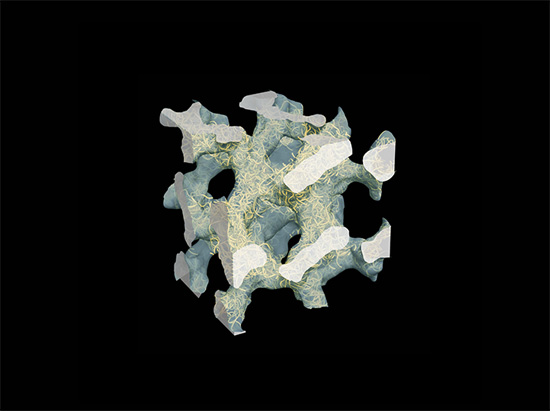Development of High-Performance Oil Absorbent for Resources Development
Discovery of a New Method for Creating mesoporous Materials from Industrial Polymers
2013.10.22
(2013.12.02 Update)
National Institute for Materials Science (NIMS)
NIMS researchers in the Polymer Materials Unit, Advanced Key Technologies Division, developed a high-performance oil absorbent with the function to purify oil-contaminated water (e.g. water discharged upon oil production) at a low cost. This new oil absorbent will provide an energy-efficient and low-cost water purification system at the site of resource development.
Abstract
- A team of researchers in the Separation Functional Materials Group of the Polymer Materials Unit (Unit Director: Izumi Ichinose), Advanced Key Technologies Division, National Institute for Materials Science (NIMS; President: Sukekatsu Ushioda), succeeded in developing a high-performance oil absorbent by creating a mesoporous material with pores of approximately 10 nm in diameter, using engineering plastics that are widely used as industrial materials.
- At the site of oil or natural gas development, a large quantity of oil-contaminated water is generated. In order to prevent such water from polluting the environment, a low-cost and efficient water treatment system has been desired. In this respect, the technology for creating a mesoporous material from a general-purpose polymer was expected to provide a method for producing a high-performance oil absorbent. However, the conventional technology was unable to form a nano-scale morphology of a porous polymer in a controlled manner, and this posed an obstacle to the production of a high-performance absorbent using a polymer.
- In the process of producing an industrial porous polymer, phase separation of a polymer solution had been widely used. Taking note of this phenomenon, that is, cryogenic separation of a polymer solution into a polymer and a solvent, the NIMS researchers succeeded in causing the solvent to form nanocrystals within engineering plastics. Then, by removing these nanocrystals by a unique method, they arrived at creating a mesoporous polymer in which nano-scale pores are connected in sequence. This mesoporous polymer can take the form of a sheet, pellet, or fiber. Under special conditions, the researchers were further able to create a polymer with pores of 1.9 nm in radius.
- The newly developed mesoporous polymer, with its large surface area exceeding 300m2 per gram, can efficiently absorb oil that is contained in water. In the test regarding the degree of absorption of cresol contained in oil-contaminated water, the researchers observed that this new absorbent can absorb more than 260mg of cresol per gram. Moreover, the new absorbent desorbs oil at a high temperature, which will make it possible to use the absorbent repeatedly. It is also excellent in absorbing gases, such as carbon dioxide, and therefore is expected to be applied as a gas separating agent.
- The research results were published in the online version of a UK science magazine, Nature Communications, on October 22, 2013, 18:00 JST (October 22, 10:00 LT) (S. Samitsu*, R. Zhang, X. Peng, M. R. Krishnan, Y. Fujii, I. Ichinose,* “Flash Freezing Route to Mesoporous Polymer Nanofibre Networks,” Nature Communications 4:2653 | DOI: 10.1038/ncomms3653).

A schematic view of a mesoporous polymer. Polymer assemblies in nanofiber form with pores of 10 to 20 nm in diameter are branched in a sophisticated fashion to create a minute three-dimensional network structure. The yellow lines represent assemblies of polymer chains that form nanofibers.
